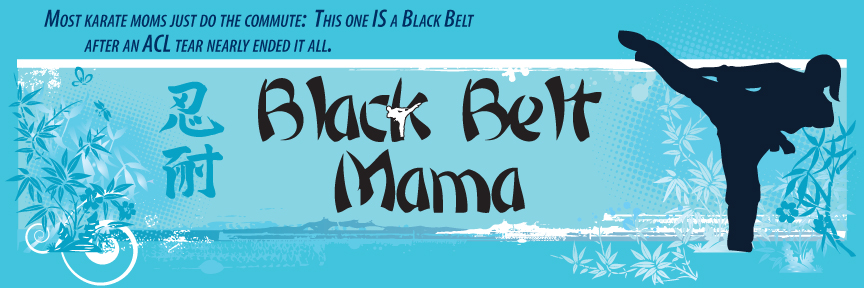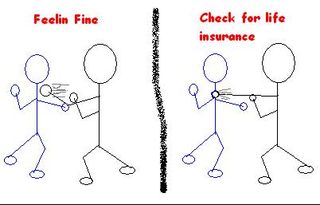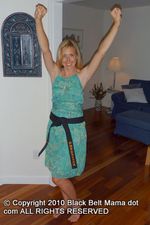March 3, 2009
The Importance of Control (Less Boring Than It Sounds)
Hey BBM fans, it's my pleasure to hop over from my normal stomping grounds to kick off this month's guest posting. I have some amazing martial artists coming after me so I''ll try not to drop the baton too early (did that ever happen to anyone in high school during track and field day? Mortifying).
I'd like to talk about control today. It's not the sexy side of karate, but control is utterly critical to becoming a mature and successful martial artist. Sure, brick breaking and board snapping is much more impressive on the surface, but some of the most awe inspiring techniques I've seen in my life are the ones that dance the razor's edge of dispatching a live partner.
Power and Control In the Beginning
When first starting a martial art, everyone wants to learn how to hit powerfully. I know I did. In order to learn how to hit with force, one has to be taught good basic body mechanics and striking technique. Luckily, with the kinds of pads, heavy bags, and impact shields found in almost every dojo, this instruction is possible.
Although the martial arts are a very long term endeavor, the basics of proper hitting can be learned fairly quickly. In fact, a common concern for instructors is that students will learn how to hit hard before learning why. This is also one of the reasons that there are both shallow and deep levels of learning in karate. But more on that later.
A Turning Point For Every Student
After a few years of training, every student comes to a crossroad (one of many) where they have to actively decide to improve their control. Unfortunately, this is a narrow path with steep edges on either side.
On one side, you have individuals who are turned off by the thought of pulling punches. They feel that the only way to develop true power is to throw bangers all session every session.
On the other side, you have people who grow accustom to not hitting anything at all. They are comfortable snapping their punches 3-4 inches away from any target in the name of safety and good practice.
Sadly, both of these mindsets are limited. In actuality, proper control needs to be executed at the right distance at full speed. Consider this graphic:
In the first panel, we see an obvious problem as our wayward attacker makes contact with his partner. A punch to the nose is clearly problematic, but strikes that are too hard to any surface of the body can cause injury and distrust amongst fellow students.
The second panel is less dangerous, but just as concerning. The attacker has completed his technique far away from his partner (which you can tell by the full extension of the arm). Although no one got hurt, the attacker is practicing bad distancing and creating habits within himself that can cause issues when trying to use his techniques for real.
The third panel represents a properly executed practice punch. The fist came extremely close without touching, and the arm still has room to 'complete' the technique through the defender, driving the defender's nose and head backward.
Tips For Developing Control
The bad thing about control is that it takes awhile to develop. One thing I do not advise is going around your dojo and throwing full speed punches at people's faces, getting as close as possible until eventually you mess up. That is a quick way to become a dojo pariah. Instead, there are some drills and strategies you can employ to slowly build up your skill.
The first concept utilizes basic focus bags. When training your strikes, take time to practice your power techniques, but also try some controlled reps. See if you can kick and punch so that you are barely scraping the bag. Since no one can get hurt, don't let up on your speed, power, or proper body mechanics. Strike and commit as best you can while pulling the hit.
The second involves a live partner. Forget about face stuff for awhile and focus on the body. Using a relaxed fist, strike in at your partner's abs or chest (this is for control drilling, not vital target practice). Allow your loosened fist to touch your partner, and then retract. You should hear a slight snap of their gi as your light strike touches it.
You can also take your practice home with you. Get some light string and a balled up piece of paper. Attach the ball of paper to the string and hang it from a doorway or ceiling fan blade. The paper is very light, so you'll get a sense of how close you strike by watching the paper's slight movements (or not so slight if you mess up).
If your ceiling fan has a speed slider, or very slow setting, you can make this a game with your kids who might be involved in karate. Just make the fan spin slowly and take turns striking at the paper. It can be fun once someone messes up and the ball starts squiggling as it spins. As you can imagine, this is actually great practice for live sparring control.
Breaking the Glass Ceiling
Proper control isn't just for good dojo etiquette; it's actually critical for learning the deeper aspects of karate and other martial arts. While a punch to the solar plexus or nose is great, there are a ton of other techniques and targets that martial arts can offer.
Palm heel, ridge hand, ippon nukite, etc. + eye, ear, throat, groin, spine, etc. = very risky business.
If a practitioner's mastery of control is anything less than stellar, they'll be unable to utilize these techniques at full speed with the right distancing and timing. Their arsenal will always be limited in variety and effectiveness; they will always be stuck under a glass ceiling, no matter how hard they strike.
While most people think of sparring as the heavily padded event we see today, kumite without padding has been around for much longer. Without pads, karateka were free to target even subtle vital points on each other's bodies and utilize small joint locking tactics. Of course, the problem with sparring without pads is that there needs to be trust and expertise between both parties involved. If you've ever thrown a spear hand technique toward someone's eyes without them expecting it, you know just how strong a reaction some of karate's more vicious techniques can elicit.
Furthermore, most of what we see of kyusho (vital point striking) is done very statically. By that I mean one person stands quite still or throws a single predicted strike, while the uke performs whatever vital point technique he happens to be demonstrating. The reason behind this is both demonstrative and fear-based. Using kyusho without perfect control in a sparring setting can result in illness, injury, or death. Therefore, most kyusho training is done below the glass ceiling because it's too much of a liability to practice otherwise.
Without being completely comfortable using techniques at any range with any sized opponent, and being able to do so correctly, there will always be limits to what a person can learn and use. In other words (if you'll indulge me in this turn of phrase), it's the lightest strike that breaks the glass.
When Control Seeps Over
One of the true gifts of karate lies in the improvements we don't readily see coming. The control I've talked about today is physical. But, in order to train for control, one has to adopt a mindset of control. By making this psychological change, the focus of karate shifts from that of power and strength to reservation and focus.
Mental adaptation tends to be infectious in a very good way. Where emotional outbursts may once have been a natural reaction in every day life, karate's imposed control begins seep in. Furthermore, a person's spirit begins to exude restraint. When that happens, it becomes much clearer when to use karate and not just how. A body, mind, and spirit of control is one of budo. A person who can embody control is one who can follow the martial way.
* * *
Matthew Apsokardu is a 3rd Degree Black Belt in Okinawa Kenpo Karate/Kobudo and student of Muso Jikiden Eishin Ryu. He is also the author of Ikigai | Blogging the Martial Way. To read more from him, visit his website or leave him a message at mapsokardu AT gmail DOT com.
This just in! Admired Martial Arts month just got even more exciting! Anyone who leaves a comment on one of the Admired Martial Artists' posts during the month of March will be entered to win a giveaway prize courtesy of Martial Arts Supplies. Leave a comment on each post, and check back often. The more comments you leave, the more chances you have to win! More giveaways are in the works! For details, go here!


























Thanks for kicking off the month’t events here! This post made me think about when I was pregnant and working with that young green belt who thought my stomach had a big target on it. Control is so very important and it’s a great topic for every martial artist to discuss. Thanks so much for contributing!
Awesome post! I am going to have this one up on my desktop for a bit today, so that I can read and re-read.
Mattsan or Jessicasan can comment if they disagree, but I think it’s worth mentioning (checks again to see if it was mentioned…..) that even when you practice on makiwara, pads, paper balls/cups hanging from a fan (thats a great idea btw!) there comes a point where you feel comfortable enough to take that to the person on person arena. Even when you practice, and have focus, you’re bound to slip up. Again, as long as you practice control, the mishap won’t be drastic, and you should only start your person on person endevors on someone who is willing to deal with your mistakes.
What I’m trying to get to, is I try to practice control, and I’m have made, and continue to make decent progress, but mistakes still happen. You’re going to make a little too much contact from time to time whether it be from someone flinching into a technique, or you being off balance.
Don’t give up, (if you work with a tolerable partner (I recommend Mattsan and Ericsan at our dojo) it’s nice because they’ll encourage you and give pointers.) Don’t annoy everyone by hitting them constantly (on accident) either, which would mean you’re not ready for person on person practice.
I love a good gentle sparring session with no pads at half-3/4 speed. I still goof, but I think you learn more about yourself and your techniques when you engage in something like this with no pads. The very thought that you can actually get popped in the eye, or nose, or jam a finger adds a small yet noticeable change to everything.
Nice write up Mattsan!
Great to see these rolling around again Jessicasan! You’re creating quite the monopoly of great martial artists here! How can the other blogs compete!?
Great article Matt! And kudos to BBM on a great post to start off March (my upcoming March-opener is hmmm…less useful!).
No one can compete with BBM Branden! She’s like the borg.
Finally, someone understands me. 😉
From what I remember from working with you, Brandensan, is that you have really great control. Maybe you were just holding back because I’m a girl and such (hope not), but you always struck me as being VERY in control.
I guess I’ll get to find out again soon. I’m coming back this week!! WOO HOO!
And as far as working with Mattsan, um yeah, I’d have to admit to hitting him in some unpleasant places in the past (I have posts to prove it), so I agree that part of learning to have control is sometimes messing up. (By the way, I’m still sorry about that horribly placed kick the one time. Oops.)
Good article. It’s interesting to read your article and think about the differences and similarities between a grappling art and a striking art. In BJJ, control is also very critical. With control, we have the benefit of being able to spar at close to 100% without serious fear of injury.
Control in BJJ (and in other similar arts) has to do with locksense, that idea of feeling how much pressure you’re exerting on a jointlock or choke.
Ultimately, regardless of style, it’s about keeping yourself and your training partners safe so that we can all go to work the next day and hopefully continue training.
Thanks for the interesting post.
My name is Foxy Citrus, and I approve of anyone beating the crap out of Sandan Apsokardu.
I would be more than happy to oblige.
Allow me to quote Danny Zuko. “Don’t make me laugh. Ha. Ha.”
Margeurite: Thanks for checking it out! I hope it helps in some way.
Branden: You’re right, slip ups are inevitable. When they are rare, it’s very easy to forgive and forget without getting gun shy with a partner.
Steve: Great point about control being critical no matter what style of martial art you undertake. I can see how BJJ would need a really good amount of communication and cooperation.
Great post! And I especially love the stick people…
Great post! I love the graphics too!
Oh how I wish everyone in my dojo had read this – before I got kicked in the back of the head by someone with no control. Not that I remember that or anything…
Great article Mattsan, esp about control seeping over (not that I’ve ever been known to have outbursts – no comment Brandensan). Most of the benefits I’ve received since studying have been outside the dojo.
BBM – thanks for the heads up and BD wishes. Nice to know that I can rely on you guys to keep me disciplined while away from home.
LOL Amanda. I’ve been there myself, but instead of my head it was my chest. Ouch. Thanks for stopping by!
No problem Mike! I hope it was a good one. Looking forward to training with you again soon!
He does stick people really well, doesn’t he? I told him he missed his calling as a graphic designer.
loved this post…. need to pass it on to some of my own sparring partners (and refer back to it often myself! *winks*).
Miss Chris: Haha, thank you. I substitute artistic talent with microsoft paint skills.
Amanda: feel free to send the link or print it out for anyone who you think might benefit from it. Or if you’re trying to give someone a little hint *ahem*.
Mike: Dealing with Brandensan must take lots of control!
Steph: I hear ya, I try to remind myself to take my own medicine from time to time.